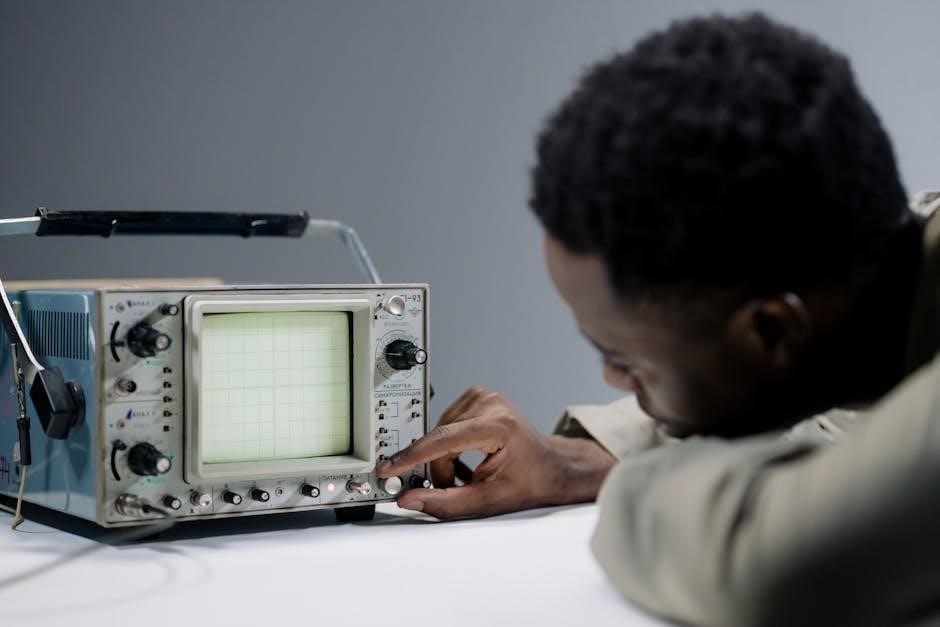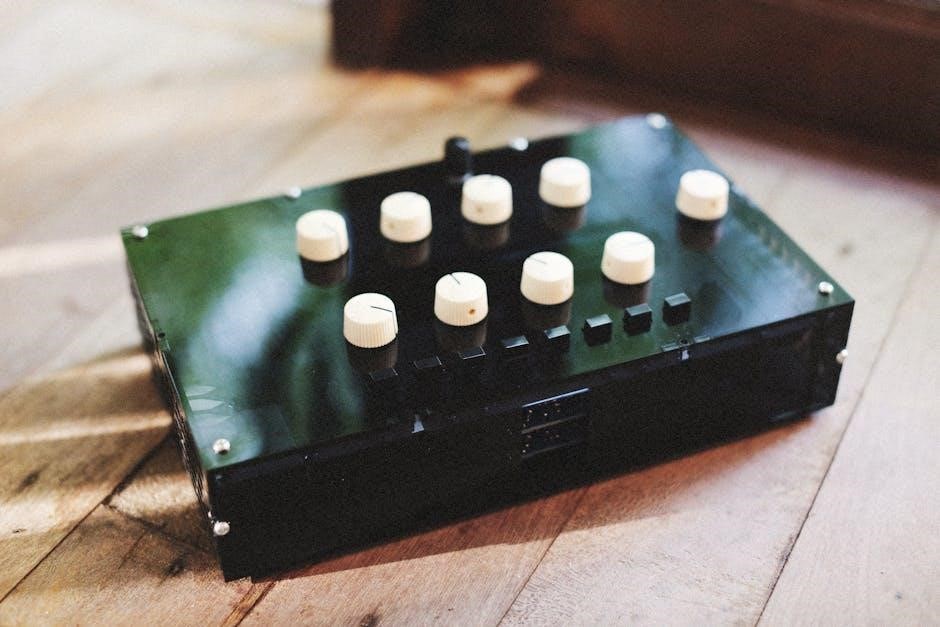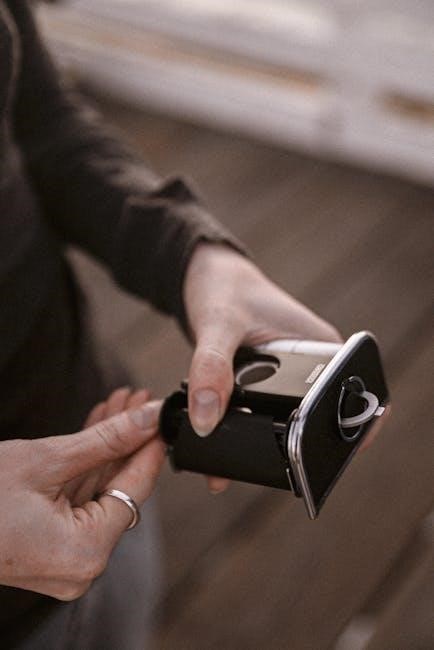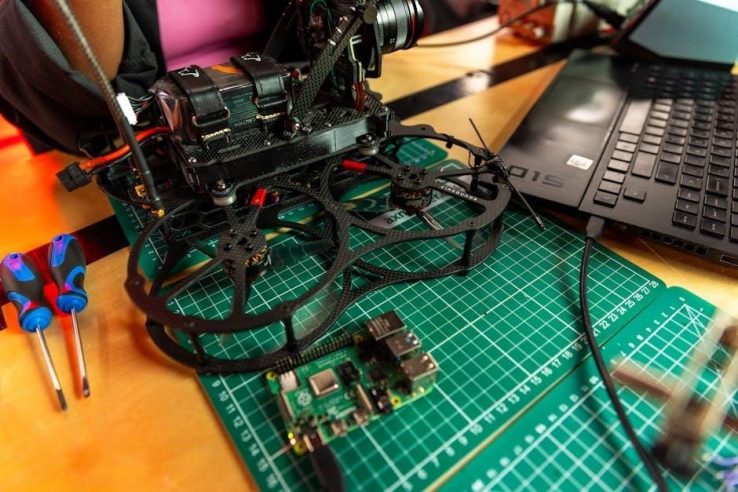This manual provides essential guidance for installing, operating, and troubleshooting Eliwell controllers, covering key features and safety measures for optimal performance in refrigeration and HVAC systems.
1.1 Overview of the Eliwell Controller
The Eliwell controller is a sophisticated device designed for precise temperature regulation in refrigeration and HVAC systems. It offers advanced features like compressor start/stop, defrost functions, and heating modes. Models such as the EWKPlus 978 and ID 974 provide multifunctional inputs and relay outputs, ensuring efficient operation. These controllers are user-friendly, with intuitive interfaces for easy setup and monitoring. They support parameter uploads/downloads via Copy Card and integration with the Eliwell AIR app for remote management. Designed for reliability, they cater to various applications, from small refrigeration units to complex HVAC systems, ensuring optimal performance and energy efficiency.
1.2 Importance of the Manual for Users
This manual is crucial for users to understand and utilize Eliwell controllers effectively. It provides detailed instructions for installation, configuration, and troubleshooting, ensuring safe and efficient operation. Users gain insights into advanced features like temperature control, compressor management, and defrost functions. The guide also covers legal aspects, such as intellectual property rights and warranty terms, protecting both users and manufacturers. By following the manual, users can optimize controller performance, prevent damage, and comply with safety standards. It serves as a comprehensive resource for maximizing the potential of Eliwell controllers in various applications.
1.3 Structure of the Manual
This manual is organized into clear, logical sections to guide users through every aspect of Eliwell controller operation. It begins with an introduction, followed by installation and setup instructions. Subsequent chapters detail features, troubleshooting, and advanced operations. Specific models are covered, along with safety precautions and legal information. The manual concludes with pairing instructions for the Eliwell AIR application and details on accessing additional resources. Each section is designed to address user needs progressively, ensuring a smooth learning curve and easy reference for both beginners and experienced users.

Installation and Setup
The installation process involves unpacking, connecting electrical components, and mounting the controller. Ensure all connections comply with safety guidelines and manufacturer recommendations for optimal functionality.
2.1 General Installation Requirements
Ensure the controller is installed in a dry, well-ventilated area, away from direct sunlight and extreme temperatures. Verify the power supply matches the controller’s voltage rating. Mount the device securely on a flat surface using the provided hardware. Follow all local electrical codes and safety standards. Avoid installing near flammable materials or in hazardous environments. Proper grounding is essential for safe operation. Use appropriate wiring to prevent interference and ensure reliable connections. Refer to the controller’s specifications for compatibility with other system components. Always turn off the power supply before starting the installation process to avoid electrical hazards.
2.2 Step-by-Step Installation Process
Begin by preparing the necessary tools and materials, including screws, wires, and a power supply. Mount the controller on a flat surface using the provided brackets. Connect the power cables to the designated terminals, ensuring proper polarity. Link the temperature sensors and other external devices according to the wiring diagram. Secure all connections tightly to prevent loose contacts. Power on the controller and check for any error messages. Proceed to configure the initial settings, such as temperature range and operation mode. Test the system to ensure proper functionality. Refer to the manual for specific wiring diagrams and configuration guidelines.
2.3 Initial Configuration and Settings
After installation, access the controller’s interface to configure basic settings. Set the operation mode (heating, cooling, or off) and define temperature setpoints. Adjust parameters like hysteresis, defrost timing, and compressor delays based on your application. Configure sensor inputs and output relays according to the system requirements. Set the desired temperature range and select the appropriate unit (°C or °F). Enable or disable features like adaptive start or remote control. Save all settings to ensure they are retained during power cycles. Test the system to verify proper operation. Refer to the manual for default passwords or specific configuration options for your model.

Features and Functionalities
The Eliwell controller offers advanced temperature control, smart defrost management, and energy-saving modes. It features a user-friendly interface, real-time monitoring, and remote access capabilities. Designed for efficiency and reliability, it optimizes performance in various applications.
3.1 Temperature Control and Regulation
The Eliwell controller excels in precise temperature control and regulation, ensuring consistent environmental conditions. It allows users to set specific temperature ranges and maintain them with high accuracy. The controller features advanced algorithms to adapt to changing conditions, minimizing fluctuations. Energy efficiency is optimized through smart cycling and adaptive control strategies. Real-time temperature monitoring and adjustable setpoints provide flexibility for various applications. The system also includes safeguards to prevent overheating or overcooling, ensuring equipment longevity and optimal performance; These features make it ideal for applications requiring stringent temperature management, such as refrigeration, HVAC, and industrial processes.
3.2 Compressor Start/Stop and Defrost Functions
The Eliwell controller efficiently manages compressor start/stop cycles, optimizing energy use and reducing wear. It automatically adjusts operation based on load demand and temperature settings. The defrost function prevents ice buildup on evaporators, ensuring consistent cooling performance. Smart sensors detect frosting conditions, initiating defrost cycles only when necessary. This maintains efficiency and prevents damage from excessive ice accumulation. The controller also ensures smooth transitions between compressor modes, minimizing operational noise and mechanical stress. These features enhance system reliability and longevity, making the controller suitable for applications requiring precise refrigeration control and energy efficiency.
3.3 Heating Function and ON/OFF Thermostat
The Eliwell controller features a heating function that ensures precise temperature regulation, suitable for various applications. The ON/OFF thermostat provides straightforward control, activating the system when the set temperature is exceeded and deactivating once the desired level is reached. This function offers energy efficiency by minimizing unnecessary operations. The controller supports dual heating and cooling modes, adapting to different environmental needs. Users can easily set temperature preferences via the interface. The system also includes safety features to prevent overheating or excessive cooling. This functionality ensures reliable performance while maintaining optimal energy usage, making it ideal for heating applications requiring simplicity and accuracy.

Troubleshooting and Maintenance
Troubleshooting involves identifying and resolving issues like error codes or connectivity problems. Regular maintenance ensures optimal performance by cleaning the unit and updating software. Resetting the controller often resolves operational glitches.
4.1 Common Issues and Solutions
Common issues with Eliwell controllers include error codes, temperature inaccuracies, and communication failures. Error codes like E1, E2, or E3 often indicate sensor malfunctions or wiring issues. Temperature inaccuracies may result from incorrect sensor calibration or faulty thermistors. Communication failures can occur due to incorrect baud rates or loose connections. Solutions involve checking wiring, recalibrating sensors, or updating firmware. Resetting the controller to factory settings can also resolve many operational glitches. Always refer to the manual for specific error code meanings and step-by-step solutions to ensure proper troubleshooting and maintenance.
4.2 Maintenance Tips for Optimal Performance
Regular maintenance is crucial for ensuring the Eliwell controller operates efficiently. Clean the unit periodically to prevent dust buildup, which can affect performance. Check all electrical connections to ensure they are secure and free from corrosion. Update the controller’s firmware to access the latest features and improvements. Replace worn-out or damaged components promptly to avoid system malfunctions. Power cycle the controller occasionally to reset internal processes and clear temporary glitches. Always use genuine Eliwell parts for replacements to maintain compatibility and performance. Refer to the manual for detailed maintenance schedules and procedures.
4.3 Resetting the Controller
Resetting the Eliwell controller can resolve operational issues without affecting its programmed settings. For a factory reset, press and hold the reset button for 10 seconds while the unit is powered on. This restores default settings but retains user configurations. For a soft reset, cycle the power supply off and on to clear temporary glitches. Ensure all configurations are backed up before performing a factory reset. Note that resetting may erase custom settings, so refer to the manual for detailed instructions specific to your model. Always test functionality after resetting to ensure proper operation.

Advanced Operations
Explore advanced features like parameter customization, data logging, and remote access for enhanced control. These operations enable tailored configurations and detailed system monitoring for precise performance optimization.
5.1 Parameter Upload and Download
The Eliwell controller allows users to upload and download parameters, ensuring configuration consistency across multiple units. This feature is particularly useful for replicating settings in large systems. Using a USB connection or RS485 interface, parameters can be transferred to and from the controller. The process involves accessing the controller’s software interface, selecting the desired parameters, and initiating the transfer. This ensures that configurations are preserved and can be restored if needed. Additionally, parameter backup prevents data loss during updates or replacements. Always test configurations on a single unit before uploading to multiple controllers to avoid system-wide issues. Proper documentation is essential for tracking changes.
5.2 Using the Copy Card Function
The Copy Card function on Eliwell controllers enables quick duplication of configuration settings between units, saving time during installation. By inserting a compatible memory card into the controller, users can transfer all programmed parameters to the card. This card can then be used to replicate settings on other controllers, ensuring consistency across the system. The process is straightforward: insert the card, select the “Copy” option in the menu, and the controller will handle the data transfer. This feature is especially useful for large installations with multiple controllers, reducing the need for manual configuration. Always verify settings after copying to ensure accuracy and compatibility.
5.3 Accessing Advanced Settings
To access advanced settings on an Eliwell controller, navigate to the “Settings” menu and select “Advanced Options.” Enter the administrator password to unlock these features. Advanced settings allow customization of operational parameters, such as temperature thresholds, defrost cycles, and compressor timing. Use the navigation keys to scroll through options and adjust values as needed. For complex configurations, connect the controller to a PC using Eliwell’s software tools. Always backup current settings before making changes. Refer to the manual for detailed instructions on specific advanced features. Exercise caution, as improper adjustments may affect system performance or safety. Ensure changes are tested thoroughly after implementation.

Specific Models
Eliwell offers various controller models, each designed for specific applications. Key models include the EWKPlus 978 and ID 974, each with unique features. The manual details specifications for each, ensuring effective setup and operation based on model requirements.
6.1 Eliwell EWKPlus 978 Controller
The Eliwell EWKPlus 978 is a high-performance controller designed for precise temperature regulation in commercial refrigeration systems. It features a wide temperature range and advanced defrost management. The controller is user-friendly, with an intuitive interface and customizable settings. It supports multiple operating modes, including cooling and heating, making it versatile for various applications. The EWKPlus 978 also integrates energy-saving features, such as adaptive defrost and smart compressor control. It is compatible with external sensors and communication modules, ensuring seamless system integration. This model is ideal for large-scale refrigeration systems, offering reliability and efficiency in demanding environments.
6.2 Eliwell ID 974 Controller
The Eliwell ID 974 is a versatile and compact controller designed for refrigeration and heating systems. It offers advanced temperature control with a user-friendly interface, making it easy to navigate and configure. The ID 974 supports multiple operating modes, including cooling, heating, and defrost, while providing precise temperature regulation. It features adaptive control algorithms for energy efficiency and optimal system performance. This controller is ideal for small to medium-sized applications, such as display cases, cold rooms, and HVAC systems. Its compact design and robust functionality make it a popular choice for installations requiring reliable and efficient temperature management.
6.3 Key Differences Between Models
Eliwell controllers vary in features, design, and functionality to cater to different applications. The EWKPlus 978 stands out with its high-resolution color touchscreen and advanced connectivity options, including Wi-Fi and Bluetooth, making it ideal for commercial and industrial settings. In contrast, the ID 974 is more compact and tailored for smaller systems, offering essential functions without advanced connectivity. While both models provide reliable temperature control, the EWKPlus 978 supports more complex configurations and integrates seamlessly with the Eliwell AIR app for remote monitoring. This distinction makes the EWKPlus 978 suitable for larger, more demanding environments, whereas the ID 974 excels in simplicity and affordability for basic needs.

Safety Precautions
Adhering to safety guidelines is crucial to prevent accidents. Ensure power is disconnected before maintenance, avoid water exposure, and follow proper calibration procedures. Wear protective gear and consult the manual for detailed instructions.
7.1 General Safety Guidelines
Always follow safety protocols when handling the Eliwell controller. Disconnect power before servicing or maintenance to avoid electrical hazards. Ensure the unit is properly grounded to prevent shocks. Avoid exposing the controller to water or moisture, as this can damage internal components. Keep the controller away from flammable materials and ensure proper ventilation. Use only approved tools and follow the manual’s instructions carefully. Wear protective gear, such as gloves and safety glasses, when performing repairs or adjustments. Never modify the controller’s design or bypass safety features. Regularly inspect the device for damage or wear and tear. Maintain a clean and dry working environment to ensure optimal performance and safety.
7.2 Electrical Safety Measures
Adhere to electrical safety measures when working with the Eliwell controller. Ensure all power sources are disconnected before performing any maintenance or repairs. Use a licensed electrician for installations to prevent faulty wiring. Avoid overloading circuits, as this can cause malfunctions or fires. Always use tools with insulated handles to minimize shock risks. Never touch electrical components with wet hands or while standing on conductive surfaces. Ensure proper grounding of the controller to prevent electrical hazards. Keep cables and wires organized to avoid tripping or damage. Regularly inspect electrical connections for wear or damage. Follow all local electrical codes and standards during installation and operation.

Legal and Compliance Information
This section outlines the legal and compliance information for the Eliwell controller, including intellectual property rights, warranty terms, and liability disclaimers, ensuring adherence to regulations.
8.1 Intellectual Property Rights
This section details the intellectual property rights associated with the Eliwell controller. All trademarks, patents, and copyrights are the property of Eliwell or its affiliates. Users are granted a non-exclusive license to use the controller’s software and documentation for its intended purpose. No ownership rights are transferred through purchase or use. Reverse engineering or unauthorized distribution of software or documentation is strictly prohibited. Violations may result in legal action. Always respect Eliwell’s intellectual property to ensure compliance with applicable laws and agreements.
8.2 Warranty and Liability Disclaimers
Eliwell controllers are provided with a limited warranty covering manufacturing defects for a specified period. The warranty does not cover damage caused by misuse, improper installation, or unauthorized modifications. Users must adhere to the manual’s guidelines to maintain warranty validity. Eliwell disclaims liability for indirect, incidental, or consequential damages arising from the controller’s use. The company’s liability is limited to the product’s purchase price. For detailed warranty terms, refer to the official documentation. Compliance with safety guidelines is essential to avoid voiding the warranty and ensuring safe operation of the controller.

Pairing Controllers with Eliwell AIR Application
Easily connect your Eliwell controller to the Eliwell AIR application for enhanced functionality, enabling seamless remote monitoring, control, and real-time data access to optimize your system’s performance effortlessly.
9.1 Steps to Pair a Controller
To pair your Eliwell controller with the Eliwell AIR application, follow these steps:
Download and install the Eliwell AIR app from the official app store.
Ensure your controller is powered on and Bluetooth is enabled.
Open the app and navigate to the “Pairing” section.
Select your controller model from the available devices list.
Wait for the app to detect and establish a connection.
Enter the pairing code if prompted (found in the controller’s settings).
Confirm pairing on both the app and controller.
Once paired, you can monitor and control your system remotely.
This process ensures a secure and seamless connection for optimal functionality;
9.2 Managing Paired Controllers
After pairing, managing your Eliwell controller through the AIR app is straightforward:
Access the “Connected Devices” section to view paired controllers.
Rename devices for easy identification.
Customize settings, schedules, and alerts for each controller.
Monitor real-time performance and adjust parameters as needed.
Use the app to update firmware or reset controllers remotely.
Troubleshoot issues by checking error codes and alerts.
Unpair devices if necessary by selecting “Forget Device.”
The app provides an intuitive interface for managing multiple controllers, ensuring convenience and efficiency.

Downloading and Accessing Manuals
Access Eliwell controller manuals via the official website, authorized distributors, or third-party platforms. Download PDFs for easy reference, printing, or sharing, ensuring you use verified sources for authenticity and compliance.
10.1 Official Eliwell Controller Manuals
The official Eliwell controller manuals are available on the manufacturer’s website or through authorized distributors. These manuals are comprehensive guides tailored to specific controller models, ensuring accurate and reliable information. They include detailed installation instructions, operational guidelines, and troubleshooting tips; Users can download PDF versions for easy access and reference. Official manuals are regularly updated to reflect the latest features and software versions. Always verify the source to ensure authenticity and avoid untrusted third-party documents. These manuals are essential for optimal controller performance and compliance with manufacturer recommendations.
10.2 Third-Party Resources for Manuals
Third-party websites often provide access to Eliwell controller manuals, offering convenience for users who prefer alternative sources. Platforms like ManualsLib, ManualsOnline, and Scribd host a wide range of manuals. While these resources can be helpful, verify the document’s authenticity to ensure accuracy. Some third-party manuals may be outdated or modified, potentially leading to confusion. Always cross-reference with official Eliwell sources for critical information. Additionally, be cautious of downloading from untrusted sites to avoid security risks. Third-party resources can supplement official manuals but should not replace them for reliable and safe controller operation.
This manual provides comprehensive guidance for Eliwell controller users, ensuring efficient and safe operation. Proper installation, maintenance, and troubleshooting are emphasized for optimal performance and longevity of the device.
11.1 Summary of Key Points
This manual provides a detailed guide for installing, configuring, and maintaining Eliwell controllers. It covers essential features like temperature regulation, defrost functions, and advanced operations. Troubleshooting tips and maintenance advice ensure optimal performance. Specific models, such as the EWKPlus 978 and ID 974, are highlighted with their unique capabilities. Safety precautions and legal information are emphasized to ensure compliance and user protection. The manual also explains how to pair controllers with the Eliwell AIR app and access additional resources. By following this guide, users can maximize the efficiency and longevity of their Eliwell controllers while ensuring safe and effective operation.
11.2 Final Tips for Effective Usage
To maximize the performance of your Eliwell controller, always follow the installation and maintenance guidelines outlined in this manual. Regularly update your software and refer to the troubleshooting section for quick resolutions. Ensure all safety precautions are adhered to, especially during electrical or defrost operations. For advanced features, explore the pairing options with the Eliwell AIR app for remote monitoring. Keep the manual handy for quick reference and consider backing up your configurations. Finally, use genuine Eliwell parts for replacements to maintain reliability and warranty compliance. By adhering to these tips, you can ensure efficient, safe, and long-lasting operation of your controller.
